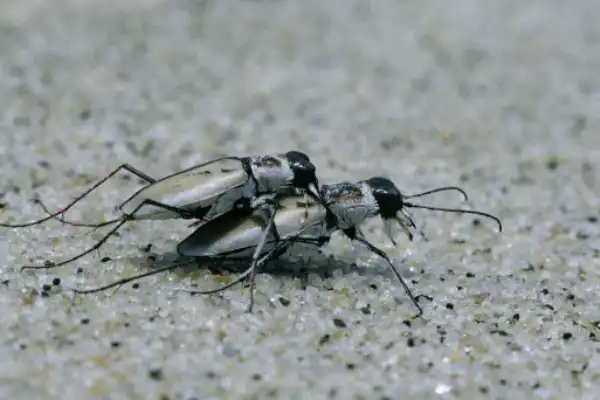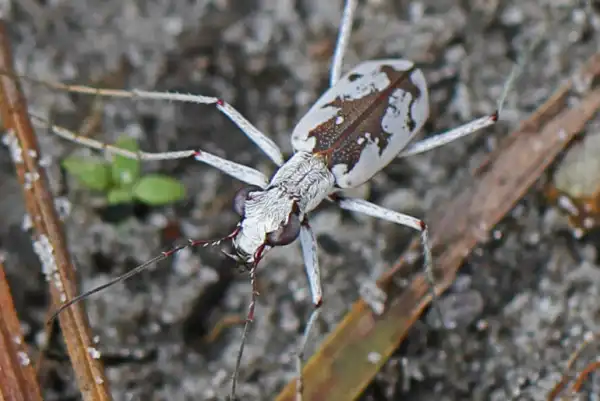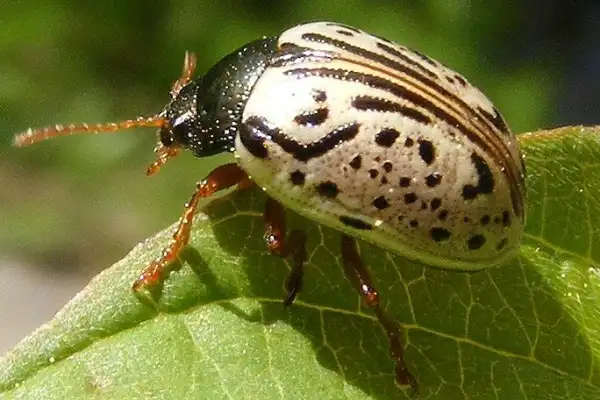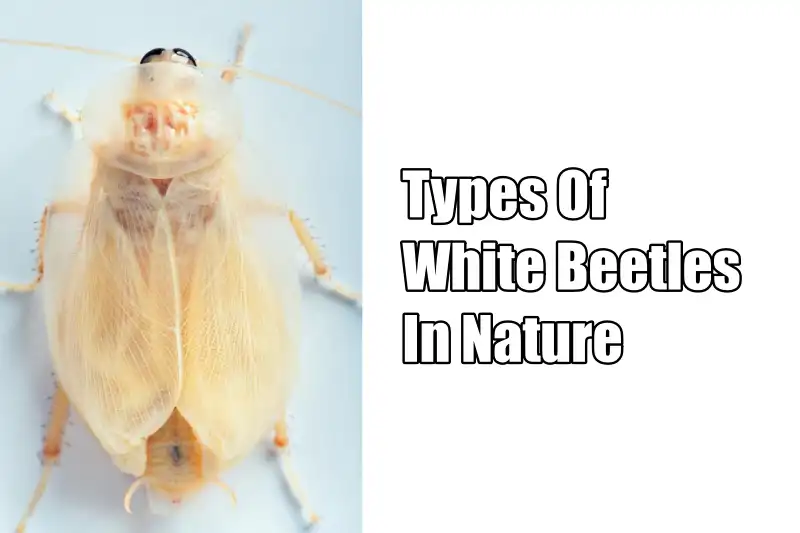We have all seen beetles around us. But are you sure those are beetles and not other insects? How do you differentiate beetles from other insects? It is the thick, hardened front pair of wings of the beetles. Beetles have a great relationship with humans. 300 of their species are eaten around the world. In ancient Egypt, these were used for beetlewing art and fighting insects for entertainment.
Most beetles are useful in nature. They do not cause economic damage and help with pest control. Beetles are of various attractive colors. Many are used as decorative displays and object collections. Among these white beetles are unique and rare. Here, we are discussing some of them.
15 Types Of White Beetles In Nature
1. Large White Cockchafer
| Scientific name | Cyphochilus apicalis |
| Size | 2-3cm |
| Identification | Bright white, hard body |
| Geographical location | China and Hong Kong |
The snow white has its name from the reflexed lip. The unusually bright beetle is white due to its disordered photonic structure, which scatters light of all wavelengths with the same efficiency, thus resulting in a white color.
What is even more amazing is that the inner body of these beetles is black. The white beetle uses the color to camouflage among white fungi.
The white beetle has surprised many scientists. Many studies have been going on about the whiteness of the beetle. The researchers say that the material used by the beetle can be produced artificially.
2. Sri Lanka Weevil
| Scientific name | Myllocerus undecimpustulatus |
| Size | 8mm |
| Identification | Yellow head and has spines on the hind femur |
| Geographical location | Sri Lanka and the United States |
This white beetle looks like sugar powder is sprinkled on their dark brown or black body. The white beetle is infamous for being a pest.
It causes a lot of damage to crops as it feeds on a large variety of plants. The females lay their eggs on the base of the host plant, so when the eggs hatch, they feed on the plant too.
The beetle is resistant to control. However, many pesticides have been discovered against these pests, like carbamate and organophosphate.
3. Eastern Beach Tiger Beetle

| Scientific name | Habroscelimorpha dorsalis |
| Size | 13-15mm |
| Identification | Bronze-green head and thorax, white body with black markings |
| Geographical location | United States |
If you are one to appreciate nature, then you will surely observe the artistic markings on the body of this white beetle. Its name is derived from their lookalike, tigers. The white beetle is found in the sand on beaches.
They feed on dead crabs and fish that wash up on the beach. The larvae of these beetles also camouflage, as some ant-like predators paralyze the larvae and lay their eggs on them.
These white beetles are highly active and are difficult to catch. When approached, they were quick to fly away. These beautiful species are, however, threatened due to increased beach use.
4. Fifteen-spotted Lady Beetle
| Scientific name | Anatis labiculata |
| Size | 7-9mm |
| Identification | rounded oval with dark spots |
| Geographical location | North America |
The white beetle does not stay white throughout its life; it darkens with maturity so much that its spots become invisible.
The beetle is found in forests but is sometimes seen on beaches. These are usually confused with Asian lady beetles. The two can be differentiated by the spots, as these do not have rings around their spots.
These white beetles feed on aphids in the trees.
5. Broad-nosed Weevil
| Scientific name | Compsus auricephalus |
| Size | 8-15mm |
| Identification | coppery head and white body |
| Geographical location | Southern USA |
There are two types of weevils: one that is completely white and one that is predominantly green. These beetles are generally confused with other species and difficult to differentiate by an ordinary man because this other species still hasn’t been named.
The white beetle feeds on such a vast variety of plants that it is still difficult to note their host since the presence of adults on a plant does not specifically mean that feeding occurs.
6. Ghost Tiger Beetle

| Scientific name | Ellipsoptera lepida |
| Size | 9-11mm |
| Identification | Dorsal cream white and green or reddish head |
| Geographical location | Central and North America |
These white beetles are known for their little dance, rocking back and forth from foot to foot to keep cool. These are also known as sand barrens, as they are often found in sand openings. These are not great fliers, but fast runners.
The beautiful snow is threatened due to habitat disturbance.
7. Blister Beetle
| Scientific name | Epicauta albida |
| Size | 18-23mm |
| Identification | white head, wings, and thorax, black legs |
| Geographical location | Central and North America |
The white beetle has a variant color morph from white to pale olive green. The beetles are infamous for their pathology. They play an important role in the economy.
The white beetle affects many crops, which are economically important, and many researchers have been going on to study the sexual behavior of these beetles. There have been cases of beetles causing diseases in horses that fed on them.
8. Moustached Tiger beetle

| Scientific Name | Ellipsoptera hirtilabris |
| Size | 11mm |
| Identification | white colouring with a mid-dorsal brown band |
| Geographical Location | Central Florida |
Have you ever seen a predator and prey of a similar size? Well, these white beetles feed on insects and anthropods of their similar size. These white beetles are found near lakes and beaches. The white color helps it camouflage in beach sand.
These white beetles are generally found around water bodies but are very difficult to spot by humans since they blend well with the background environment.
9. Dogwood Leaf Beetle

| Scientific Name | Calligrapha philadelphica |
| Size | 8mm |
| Identification | The cephalothorax of this Beetle is black with white spots |
| Geographical Location | North America |
Do you like contrasting colors, black and white? Then this while beetle would definitely be your liking. It is known for its black-and-white contrasting colors. This beetle feeds on dogwood, hence the name. For their entire lifespan, these beetles never stay away from dogwoods.
The life span of this white beetle lasts for three months, which starts from a simple egg to a complex adult.
10. Little Leaf Notcher
| Scientific Name | Artipus floridanus |
| Size | 6.25 to 14mm |
| Identification | white body with tiny black spots |
| Geographical Location | Florida, the Caribbean, and the Bahamas |
In Florida, these white beetles are known as “citrus-eating bugs.” Hence, they are often found while eating grapes, oranges, and lemons. Due to this, these white beetles pose a huge economic threat.
This white beetle is mainly treated as a pest, causing huge damage to citrus fruits. These white beetles mainly feed on the leaves of citrus trees.
11. Common Willow Calligrapher Beetle
| Scientific Name | Calligrapha multipunctata |
| Size | larger than 6mm |
| Identification | black cephalothorax with white marks |
| Geographical Location | North America |
These white beetles are most commonly found in humid areas like lakes, rivers, and streams. The unique feature of this beetle is that it has orange-brown legs. This white beetle eats willow leaves, hence the name.
These white beetles are food for rose-breasted grosbeak birds. These beetles help in the fertilization of white melilot flowers.
12. White Oak Borer Beetle
| Scientific Name | Goes tigrinus |
| Size | grows up to 34mm |
| Identification | white-coloured body with brown marks |
| Geographical Location | North America |
These white beetles are pests of oak trees. Young oak trees suffer from these pests when compared to aged oak trees. It mimics the oak tree bark with brown marks on its body.
These white beetles cause so much hindrance to the economic value of the oak tree. Their life span lasts for 5 years, which is a threat to the oak tree, so much so that it might even kill a tree.
13. Angel Trumpet Weevil
| Scientific Name | Trichobaris compacta |
| Size | does not grow beyond 17mm |
| Identification | white color with black spots |
| Geographical Location | North America |
These white beetles survive on host plants by eating the leaves of that host. These beetles have a special feature of noticing toxic hosts by sensing volatiles.
Another interesting feature of this species is that its legs are white, too. Sometimes, these species are seen in pale green, too.
14. Mexican Beetle
| Scientific Name | Zygogramma disrupta |
| Size | 34mm |
| Identification | black head, black stripes on white elytra |
| Geographical Location | North America |
These white beetles are widely associated with ragweeds. It eats leaves and, hence, is a leaf beetle. A short black antenna is present on the forehead of these white beetles.
A yellow and black morph is the least common kind that is to be found. In the 1980s, this white beetle was introduced in Russia.
15. Inflated Beetle
| Scientific Name | Cysteodemus armatus |
| Size | 15mm |
| Identification | large butt with white or yellow color |
| Geographical Location | Central and North America |
The white beetle gets its name from its big butt. They are found on the floor of the desert during the spring. This beetle is a good pollinator and is always found with pollen on its back. The beetle can cause toxic reactions and cause blisters in humans when bit.
The white beetle feeds on a wide range of plants. However, they do not cause any major problems. They feed on other smaller arthropods too.
Conclusion
Though these are some of the white beetles, can you recognize them when you see them somewhere? All the above-mentioned white beetles have distinct identification features. I hope you will recognize them somewhere when you see them.
Some of these white beetles are becoming extinct, and some are pests, which causes a huge economic threat.
Also Read:
